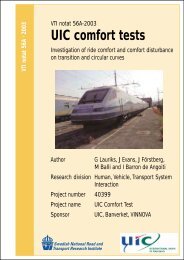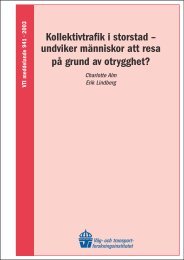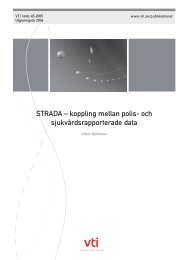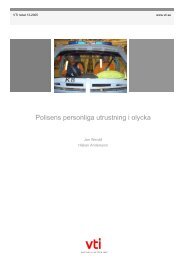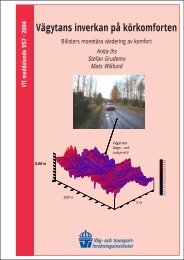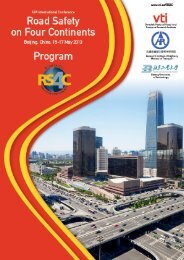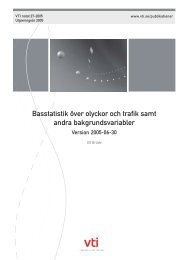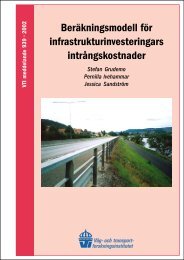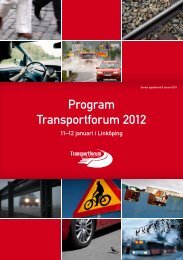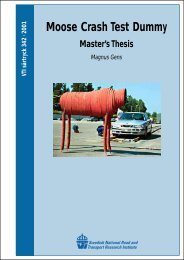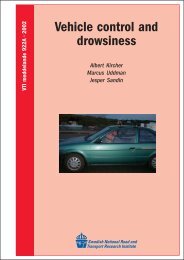Missing text /vti/pages/publication/downloadpdf for sv
Missing text /vti/pages/publication/downloadpdf for sv
Missing text /vti/pages/publication/downloadpdf for sv
You also want an ePaper? Increase the reach of your titles
YUMPU automatically turns print PDFs into web optimized ePapers that Google loves.
Experience of international freight<br />
by Inge Vierth<br />
VTI (Swedish National Road and Transport Research Institute)<br />
SE-581 95 Linköping Sweden<br />
Summary<br />
National freight model development and application in Finland, Norway, Denmark,<br />
Germany and the Netherlands and within the EU has been compiled. This has been done<br />
based on questions <strong>for</strong>mulated by the Swedish government agency Transport Analysis.<br />
The questions address infrastructure planning, work with the freight models and current<br />
development. The responses <strong>for</strong> the other countries were compared to the Swedish<br />
situation, where the Swedish Transport Administration is responsible <strong>for</strong> the transport<br />
<strong>for</strong>ecasts, cost benefit analysis and the development of methods and models.<br />
The review revealed several parallels in terms of need <strong>for</strong> analysis in the considered<br />
countries and the EU. The fact that the same types of fees and regulations are discussed<br />
is not surprising given that requirements are determined at the EU or global level. When<br />
it comes to infrastructure planning, different countries focus on different aspects<br />
according to their geographical location etc. All countries produce aggregated transport<br />
<strong>for</strong>ecasts, however, not all countries have the same practice <strong>for</strong> detailed flow <strong>for</strong>ecasts<br />
that are required <strong>for</strong> cost benefit analysis (to rank projects). In Finland, <strong>for</strong> example,<br />
there are no detailed transport <strong>for</strong>ecasts <strong>for</strong> the whole country as in Norway and<br />
Sweden.<br />
Most of the input data used in the national freight models are derived from transport<br />
statistics and economic statistics that are EU-regulated. It is unique <strong>for</strong> Sweden that<br />
three national Commodity Flow Surveys have been carried out. This means more data<br />
are collected in Sweden than in most other countries. As we understood, however, the<br />
access to data <strong>for</strong> model development is not assured as be<strong>for</strong>e, when SIKA was<br />
responsible <strong>for</strong> both statistics and transport models.<br />
The review shows that there is not one given organizational solution in terms of<br />
ownership and management of transport models. In most countries, the responsible<br />
ministries have roles as <strong>for</strong>mal owners and clients, except <strong>for</strong> Norway and Sweden. In<br />
Denmark, the model development is linked to an academic research environment at<br />
Denmark's Technical University. Due to the lack of transparency and openness, the<br />
organizational solutions in Germany and Finland where consultants handle the models<br />
without public control are not compatible with the Swedish requirements <strong>for</strong> decisionmaking.<br />
Sweden has applied various organizational models over time. As we have understood,<br />
the Maritime Administration does not feel that they are part of the modelling work in<br />
today’s practice. This means that there is a risk that the intermodal perspective is not<br />
guaranteed. Another problem with today's solution is that it does not address transport<br />
policy in general. Many maritime, aviation and climate policy as well as and other<br />
issues are wholly or partly outside the Transport Administration and there is a risk that<br />
these issues are not addressed in a model that is completely controlled by the Transport<br />
Administration. It is there<strong>for</strong>e necessary to find a development and management model<br />
that meets all requirements.<br />
The review has shown that experiences in other countries are interesting reference<br />
points <strong>for</strong> future discussions of how Sweden should handle issues associated to model<br />
VTI notat 27-2011 7



